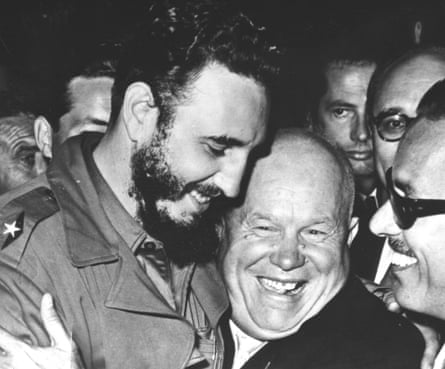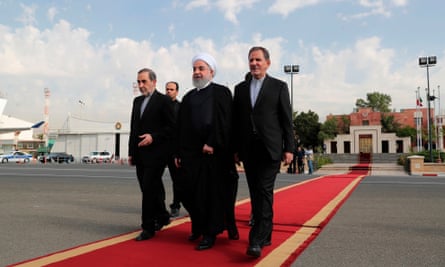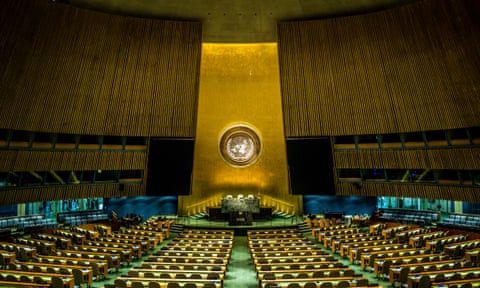What is the general assembly?
The UN general assembly is the world’s parliament, where all the UN’s 193 member states are represented. Each sovereign state gets one vote so it is not exactly representative of the world’s population but then again, its votes are not binding on the membership, except in budgetary matters.
The general assembly is not nearly as powerful as the security council, which can pass binding resolutions, and is dominated by the five permanent members, the US, China, the UK, France and Russia, who each have a veto.
But the general assembly can express world opinion, make recommendations to the security council and elect the council’s non-permanent members. The 74th session takes place this month.
The general assembly and the security council are two of six main organs of the UN. They sit alongside the secretariat (the general secretary, António Guterres’, office), the international court of justice (seated in The Hague), the economic and social council (a policy coordination body) and the trusteeship council.
Why is this week important?
The only time the world really pays heed to its great talking shop is the week commencing 23 September, when the high-level general debate takes place at its customary moment in the annual diplomatic calendar.
The world’s leaders converge on New York, where each is given an (unenforced) time limit of 15 minutes to speak in front of the green marble podium and orate in front of the world. Leaders occupy positions in the hall in alphabetical order by country name, usually with a different nation occupying the first seat each year.
In truth, the general assembly week usually makes news in the first day or two, when the US president and other powerful heads of state tend to have their moment, and then attention tends to tail off.
For that reason, there is always some horse trading before the general assembly week, with prime ministers from big countries trying to swap speaking slots with presidents of small countries.

The general assembly is also the preferred venue for America’s great antagonists to land a few blows while on US soil. Nikita Khrushchev, Hugo Chávez and Muammar Gaddafi all had a go at this. Gaddafi unleashed a 90-minute diatribe in 2009 but that was pithy compared to Fidel Castro’s record 269 minutes in 1960.
More recently, Binyamin Netanyahu made headlines in 2012 by bringing visual aids to illustrate his allegations against Iran, one of them a cartoon bomb.
Does anything ever get done at the general assembly?
Good question. It is more about posturing than policy but there are summit meetings on critical subjects. Barack Obama chaired a meeting on nuclear proliferation at his first general assembly in 2009.
This year, there is a climate action summit on the eve of the general debate, attended by the teen activist, Greta Thunberg. Putting the climate emergency centre stage and forcing states to do something are two very distinct things, however.
What do New Yorkers make of it?
Not a lot, it has to be said. A large section of east midtown Manhattan is closed to traffic and roads outside the zone are frequently blocked to allow for the motorcades criss-crossing the area. The sidewalks are filled with people in suits with collections of passes around their necks arguing with police about which entrances they can use.
It is good news for midtown hoteliers, however. They are booked up months in advance. The power centre during general assembly week used to be the Waldorf Astoria, where the US ambassador’s residence was situated in a penthouse suite. It is also where the US would host many of its meetings in the margins of the general assembly. But the US moved out after the hotel was bought by the Chinese insurance group, Anbang.
One visitor tried to break with the routine of luxury hotels. When he attended in 2009, Gadaffi tried to pitch an enormous tent in the town of Bedford, 45 miles north of New York, until the locals complained. The owner of the site said he had no previous knowledge of Gaddafi’s camping intentions. The landlord’s name: Donald Trump.
What should we look for at this year’s general assembly week?
The big question this year, like last year and the year before that, is who is going to meet whom on the sidelines of the assembly. In that way it has the same compelling appeal as a dating show, watching two people who plainly hate each other try to find something in common. This year, like last year, there was some early anticipation of a meeting between Trump and his Iranian counterpart Hassan Rouhani. That started off unlikely and has veered towards the near impossible following last week’s attacks on Saudi oil installations.
Trump and Rouhani both face resistance within their own governments to any form of reconciliation. There would have to be a significant easing of sanctions for Rouhani to agree to a Trump meeting on the sidelines of the general assembly but there are few signs that Trump would be willing to do this.
Trump might be keen to spring a surprise encounter, to generate some positive headlines, but that is not how Tehran operates. Rouhani is still being criticised in Iran for taking a phone call from Barack Obama as Rouhani was leaving UNGA in 2013, without checking in first with Iran’s supreme leader.
Brazil’s president Jair Bolsonaro was expected to make his UNGA debut, to defend his policies against the near consensus view that they are destroying the Amazon. But his attendance is in doubt in the wake of surgery for a hernia caused by a knife attack during the campaign a year ago. He has vowed to show up, even if confined to a wheelchair. It is a unique opportunity to grab the global spotlight. By an accident of UN history, it is traditional for the Brazilian head of state to be the first world leader to talk at UNGA, on the first morning while everyone is still paying attention. Bolsonaro’s doctors however, may take a different view.

Boris Johnson might welcome his general assembly appearance as a diversion from domestic woes. A second meeting with Trump is likely as both men have an interest in not looking isolated on the world stage. Face time with a US president is always an objective for most visiting leaders, to show their electorates their importance on the world stage.
The circumstances of such an encounter can also be important. In 2009, the then UK prime minister, Gordon Brown, was desperate for even a brief meeting with Barack Obama. The meeting finally happened but under humiliating circumstances. Brown got a “walk and talk” with Obama in the UN kitchens. As Obama strode past the pots and pans and gas ovens, Brown had to try to keep up and talk, out of sight of the world’s cameras.
Trump could try to achieve something on his stalled North Korea talks at this general assembly, either some progress with the Pyongyang regime, or a meeting of security council powers, in a bid to fix the holes in sanctions enforcement and put the screws back on.
Trump’s speech is expected to focus on global religious freedom, and he could well refer to the current US priorities at the UN, fighting abortion rights around the world and for a conservative stance on gender issues.
Any no-shows?
Some leaders might not bother with the general assembly at all. Vladimir Putin is a regular no-show. The Russian president tends to come only once a decade and the last time was in 2015.
A bigger question is whether Venezuela’s beleaguered president, Nicolás Maduro, will turn up. He came at the last moment in 2018, but this year, with the US and its allies no longer recognising him as head of state and accusing his regime of numerous crimes, his presence in New York, even as the theoretically protected guest of the UN, would be a much more risky endeavour.
Who runs the general assembly?
Although it is the UN secretary general who gets the limelight for most of the year, the event gives the president of the general assembly, elected each year by the member states ahead of general debate, a chance to shine.
This year it is Nigeria’s Tijjani Muhammad-Bande. After the initial excitement of greeting the world leaders, however, it is rather a thankless task, introducing each leader to the assembly and then sitting through one speech after another, most of them turgid and self-congratulatory.
What about the sideshows?
This is the world’s biggest summit and it attracts a lot of side events because of the proximity and potential participation of world leaders. The most glittering of these events is the Goalkeepers conference run by the Bill and Melinda Gates Foundation, where celebrities, activists and politicians will talkbout global inequality.
